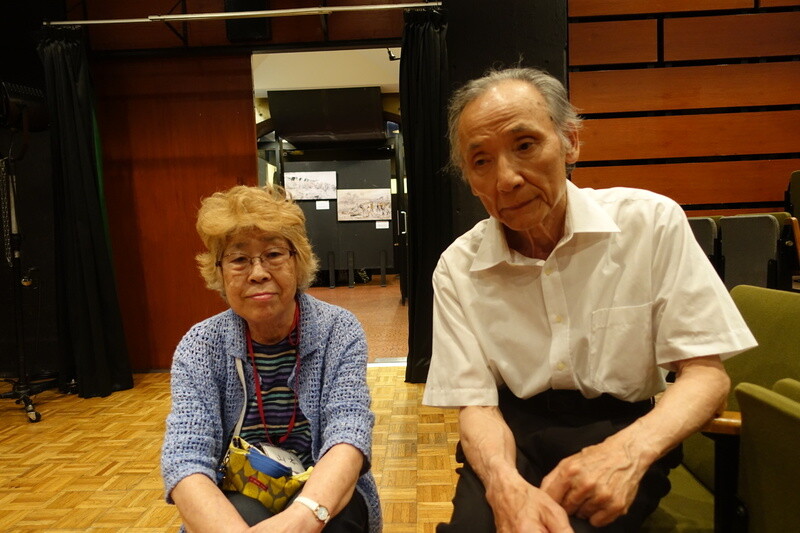hankyoreh
Links to other country sites 다른 나라 사이트 링크
A play teaching the history of the Great Kanto Earthquake massacres to Japanese youth

“Rumors were spreading that gangs of Koreans and socialists were planning to burn down whole villages that hadn’t been burned yet. As darkness fell, the rattle of gunfire and shouts could be heard in the distance.”
On June 3, a narrated play about the massacre of Koreans during the Great Kanto Earthquake titled “The Camera of My Retina: Diary of the Great Earthquake of 1923” opened at a small theater in the city of Yokohama, Kanagawa Prefecture. These lines describing the massacre of Koreans at the time of the earthquake were taken from an actual diary that recorded the massacre.
Kazuyoshi Fukuchi, 73, who wrote the script and directed the play, discovered these lines in his father’s diary. While going through his deceased father’s belongings in 1986, this theatrical actor and producer found a diary detailing the Great Kanto Earthquake. At the time of the earthquake, Fukuchi’s father was a 14-year-old boy living in the Koto Ward of Tokyo. It was last year when Fukuchi resolved to write the play, after perusing the diary. The Kumamoto earthquakes and the increasing severity of hate speech in Japanese society motivated him to focus the play on his father’s description of massacres of Koreans. Based on his father’s diary, Fukuchi wrote the script from the eyes of a teenage boy watching the Great Kanto Earthquake, and the play premiered in Tokyo last year.

While writing the script, Fukuchi referred to his father’s diary and historical records. A scene in which individuals are told to say “five yen and 50 sen” (which was hard for Koreans to pronounce) or to recite the Imperial Rescript on Education to figure out if they‘re Korean or Japanese and a scene in which the police egg on the massacre of Koreans on the street by telling people over a loudspeaker to contact the police if they come across any “Futei Senjin” (malcontent Koreans) are based on the historical record.
“What was it that made ordinary people murder them [the Koreans and socialists]?” asks Seikichi, a boy who is the main character in the final part of the play.
The reprise of the play in Yokohama took place at the request of Sumiko Yamamoto, 78, a civic activist who has been researching the massacre of Koreans in the area during the Great Kanto Earthquake and making an effort to bring attention to the incident. “Yokohama is the place where the history of the massacre of Koreans has been subject to the greatest cover-up. While it’s estimated that 3,000 of the 6,000 Koreans who are thought to have been massacred around the time of the Great Kanto Earthquake were killed in Yokohama, the number of victims is 0 because there are no concrete records,” said Yamamoto. “I want young people to have insight into history. I have a problem with a world that thinks nothing of hate speech and calling for people’s death.” At the beginning of this month, Japan’s confirmed that it had no plans to express regret for the massacre of Koreans during the Great Kanto Earthquake.
By Cho Ki-weon, Tokyo correspondent
Please direct questions or comments to [english@hani.co.kr]

Editorial・opinion
![[Editorial] Exploiting foreign domestic workers won’t solve Korea’s birth rate problem [Editorial] Exploiting foreign domestic workers won’t solve Korea’s birth rate problem](https://flexible.img.hani.co.kr/flexible/normal/500/300/imgdb/original/2024/0626/5517193887628759.jpg) [Editorial] Exploiting foreign domestic workers won’t solve Korea’s birth rate problem
[Editorial] Exploiting foreign domestic workers won’t solve Korea’s birth rate problem![[Column] Kim and Putin’s new world order [Column] Kim and Putin’s new world order](https://flexible.img.hani.co.kr/flexible/normal/500/300/imgdb/original/2024/0625/9617193034806503.jpg) [Column] Kim and Putin’s new world order
[Column] Kim and Putin’s new world order- [Editorial] Workplace hazards can be prevented — why weren’t they this time?
- [Editorial] Seoul failed to use diplomacy with Moscow — now it’s resorting to threats
- [Column] Balloons, drones, wiretapping… Yongsan’s got it all!
- [Editorial] It’s time for us all to rethink our approach to North Korea
- [Column] Why empty gestures matter more than ever
- [Editorial] Seoul’s part in N. Korea, Russia upgrading ties to a ‘strategic partnership’
- [Column] The tragedy of Korea’s perpetually self-sabotaging diplomacy with Japan
- [Column] Moon Jae-in’s defense doublethink
Most viewed articles
- 1Blaze at lithium battery plant in Korea leaves over 20 dead
- 2How sanctions are backfiring to fuel a new Eurasian alliance
- 3[Column] Kim and Putin’s new world order
- 4CIA record confirms US ‘completely destroyed’ Seoul’s Haebangchon in 1950 bombardment
- 5What made Korea’s lithium battery plant fire so deadly
- 6[Editorial] Workplace hazards can be prevented — why weren’t they this time?
- 7Foreign day laborers make up majority of death toll in Korean battery factory fire
- 8Is Korea ready to protect the rights of Filipino domestic workers arriving this fall?
- 9Dispatched into unknown danger, foreign day laborers were defenseless against blaze
- 10After Putin’s Pyongyang summit, Seoul and Moscow play dangerous game